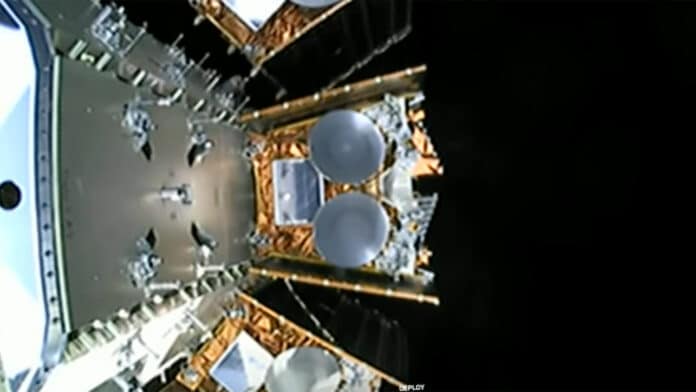The European Space Agency (ESA) has finished initial in-orbit testing of its advanced broadband satellite providing high-speed internet services that demonstrate next-generation 5G connectivity.
Designed to offer high-speed internet connectivity anywhere on Earth, the broadband satellite has been nicknamed ‘JoeySat’ after a baby kangaroo for its beam-hopping abilities. JoeySat is placed in low-earth orbit and can connect thousands of people traveling by air, sea, or land.
The satellite is able to remotely direct and boost its beams to focus coverage to certain locations, such as areas of high usage where the network is struggling to cope with demand.
JoeySat’s technology will be able to swiftly switch the satellite capacity between different places on Earth up to 1,000 times per second. This enables it to provide services from managing real-time surges in commercial demand to providing broadband on planes and responding to emergencies and natural disasters.
The signal strength can also be rapidly deployed to 5G mini hubs connected to the OneWeb communication network to help meet wider service demands.
JoeySat is being developed under the Sunrise Partnership Project between ESA and telecommunications operator OneWeb, with backing from the UK Space Agency. Its advanced digital beam-hopping and beam-steering payload – the ‘brains’ of the satellite – was built, tested, and fully qualified by communications equipment company Satixfy. The flexible payload is fully software defined and will be reconfigurable in orbit.
JoeySat was launched into low Earth orbit on 20 May from the Vandenberg launch pad in California, exactly two years after ESA and OneWeb signed the contract to collaborate on the satellite’s development.
Since then, it has completed commissioning tests of its platform and payload and begun its one-year test campaign of its innovative features. The features include a digitally regenerative onboard processor and a multi-beam phased array that incorporates beam-steering and beam-hopping antennas.
JoeySat is in a near-polar orbit and will send signals via ground stations in Norway and Sweden to demonstrate the full capabilities of flexible payloads in next-generation constellations with global connectivity. Experiments will include end-to-end communications with dynamic resource allocation and 5G pilot tests with the University of Surrey.
“It is exciting to see OneWeb’s JoeySat pass its initial in-orbit tests so that it can move on to demonstrate the huge potential of its innovative beam-hopping technology to enhance connectivity and improve people’s lives, whether that means better broadband services in remote places, or the ability to respond more effectively to emergency situations,” Harshbir Sangha, Missions and Capabilities Delivery Director at the UK Space Agency, said in a statement.
